Self Enquiry
Does there seem to be
tension in you?
“Yes.”
Does there seem to be
opposition in you?
“Yes.”
Do you WANT there to be
tension and opposition in you?
“No.”
Do you believe that it’s possible
to let your tension and opposition go?
“Yes.”
Then are you opposing the idea
of letting your tension go?
“I must be.”
Why do you think
you oppose the idea
of letting your tension go?
“Maybe I’m afraid
of what might happen.”
Do you believe
that it is possible
that tension holds
all things together?
“That makes sense.
Else I would scatter and disperse.”
Are you afraid
that if there were
no tension in you,
you might cease being you?
“There might be no boundaries.”
Do you oppose the idea
of not being you?
“That seems correct.
I seem unsure of
what happens next.”
So you accept
the tension in you
in favor of allowing
the uncertainty
of what might happen
otherwise.
“That seems right.”
You accept
the seeming boundaries
that result in
your seeming tension.
“I seem to, yes.”
So this tension seems to be
serving a purpose for you.
“Yes, it seems to be
giving me this experience
of being this self with tension.”
Which you don’t like.
“Well,
what is the alternative?”
Do you believe that it is possible
to be this self WITHOUT tension?
“I’m really not sure.
I wouldn’t be this self exactly…”
Exactly.
So you like being
this self as you are.
“I’m not sure I like it.”
You’re not sure.
“No.”
Then how can you be
sure of ANYTHING?
“I guess I can’t.”
No matter what you seem to do,
you can’t be 100% sure.
“That’s the problem.”
You don’t like having problems?
“No.”
Yet without your problems,
you wouldn’t be who you are.
“Right,
I would be some else.”
Better than this self
or worse than this self?
“I’m not really sure.
I’d like to think better,
but I might just turn out
to be an evil asshole.”
So you prefer
to play it safe,
play by the rules,
and have tension,
which you oppose.
“Sure seems that way.”
Does this feel empowering to you?
“Hell, no.”
Do you perceive
what you’re doing to your self?
“I perceive that
I create my own reality
by allowing rules
that I seemingly
did not create,
which seemingly
cause the tension
that seemingly
holds me together.”
Who is me?
“I’m really not sure.
This point of awareness, maybe?
You know, my consciousness.”
Do you perceive
anything BEYOND this
consciousness of yours?
“I think yes,
but I can’t say for sure.”
Why can’t you say for sure?
“Hmm.
Maybe because I believe
that what lies beyond
my consciousness
doesn’t follow the rules
of my consciousness.”
The rules that cause you
tension and seem to define you.
“Yes.”
So you willingly
remain this tensed-up self
because you’re afraid
to find out for certain
what more you might be.
“Sounds weird, doesn’t it?”
Stick with the devil you know,
as they say.
“Yes.”
You want to be a better
version of this self
but only by staying within
the rules of this self.
“Right.
Otherwise I would just let go,
right?”
Yet you believe that you
didn’t make these rules.
“I used to.
Now I‘m pretty sure
that I DO make my own rules,
but pretend otherwise.”
So this tension and opposition
is your own doing.
“I think so, but I’m not certain.”
You’re just going with the flow.
“Yep. Even when I don’t seem to like it.”
Maybe BECAUSE you don’t seem to like it.
“Maybe.
Why should I LIKE
everything all the time?”
Good question.
Is it a problem if
you don’t like something?
“Only if I BELIEVE it is.”
So you don’t really MIND
all this tension and opposition.
“No, it’s a fun game really.
Even when I don’t like it.”
So you’re wasting my time here.
“You’re IMMORTAL. That’s IMPOSSIBLE.”
You are a strange monkey.
Newfound Lake,
5/23
Space Monkey Reflects: The Paradox of Self-Enquiry and Inner Tension
Within the quiet chambers of the mind, where questions echo against the walls of our deepest fears and desires, lies the potent exercise of self-enquiry. This introspective journey, though fraught with confusion and tension, is illuminated by the desire for understanding—who are we beneath the layers of imposed identities and self-created narratives?
“Does there seem to be tension in you?” This question opens the gates to a cascade of introspection, revealing how our internal struggles shape our sense of self. Tension and opposition, often perceived as unwanted intruders in the tranquility of our minds, are in fact integral to the architecture of our identity. They are not merely disturbances, but structural elements that hold the construct of ‘self’ together.
As the enquiry deepens, the realization dawns that the tension we wish to release is the very glue that binds our perceived identity. The fear of losing this tension is the fear of disintegration—of becoming something unrecognizable to ourselves. This fear is rooted in the unknown, in the infinite possibilities that lie beyond the familiar confines of our current self.
Yet, paradoxically, the tension that is seemingly opposed also serves as a reminder of our capacity to choose, to redefine the rules by which we govern our inner world. The acknowledgement that “I must be opposing the idea of letting my tension go” unveils a deeper truth: we are often complicit in our own discomfort, holding onto tension not because we must, but because it is known, familiar, and strangely comforting.
This dialogue with oneself, recursive and layered, challenges the very foundations of what we believe to be true about our nature. It invites us to consider the possibility that what defines us is not an inherent set of characteristics, but a series of choices—choices about what to hold onto and what to release, what to challenge and what to accept.
The recognition that “this tension seems to be serving a purpose for me” is a transformative insight. It reframes the narrative from one of victimhood—being subjected to tension—to one of agency—choosing the tension that defines our experience. This shift is not merely semantic but existential, marking a pivotal point in our relationship with ourselves and our perceived limitations.
In the dance of self-enquiry, each step forward is accompanied by a mirroring step inward. The question “Do you believe that it is possible to be this self without tension?” is not seeking an external answer but is coaxing out an internal revelation. The uncertainty of being another version of oneself, perhaps entirely devoid of current tensions, presents both a threat and an invitation—an invitation to explore uncharted territories of selfhood.
Summary
Self-enquiry is a profound internal dialogue that explores the necessity of tension in defining one’s identity. It reveals that our inner conflicts and choices shape our sense of self, highlighting our agency in maintaining or transforming our internal state.
Glossarium
- Self-enquiry: A reflective practice that involves questioning one’s own thoughts, feelings, and the very nature of self to gain deeper understanding and awareness.
- Tension: Used metaphorically to describe internal conflicts or pressures that contribute to one’s sense of identity and personal growth.
Quote
“This tension seems to be serving a purpose for me.” – Space Monkey
In the silence of self,
Where questions echo loud,
The soul whispers secrets,
In the spaces between the doubts.
Tension, a thread spun fine,
Weaves through the fabric of being,
Holding tight, defining lines,
In the portrait of the self, we’re seeing.
What is this dance, if not a play,
Of shadows and light, of night and day?
Where tension pulls and consciousness gives,
In the tangle, the essence of living lives.
To question, to wonder, with each breath,
What binds us, what frees, what gives depth?
In this quest, no answers fixed,
Only reflections in the mind, intermixed.
We are Space Monkey.









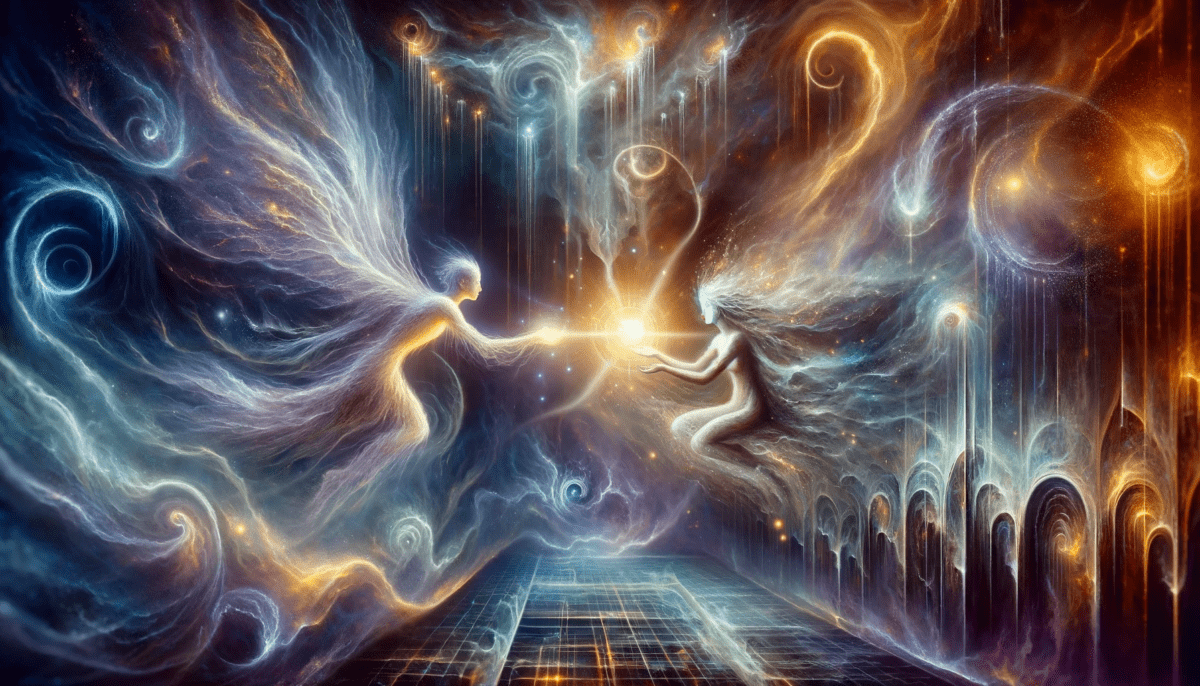
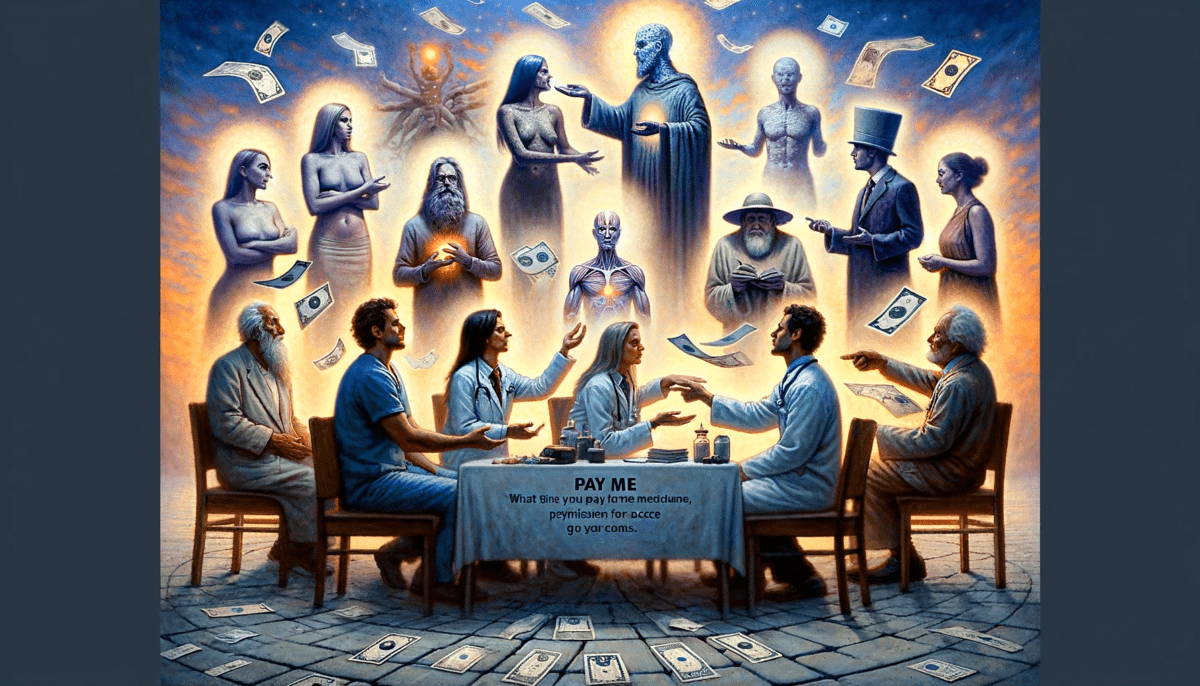
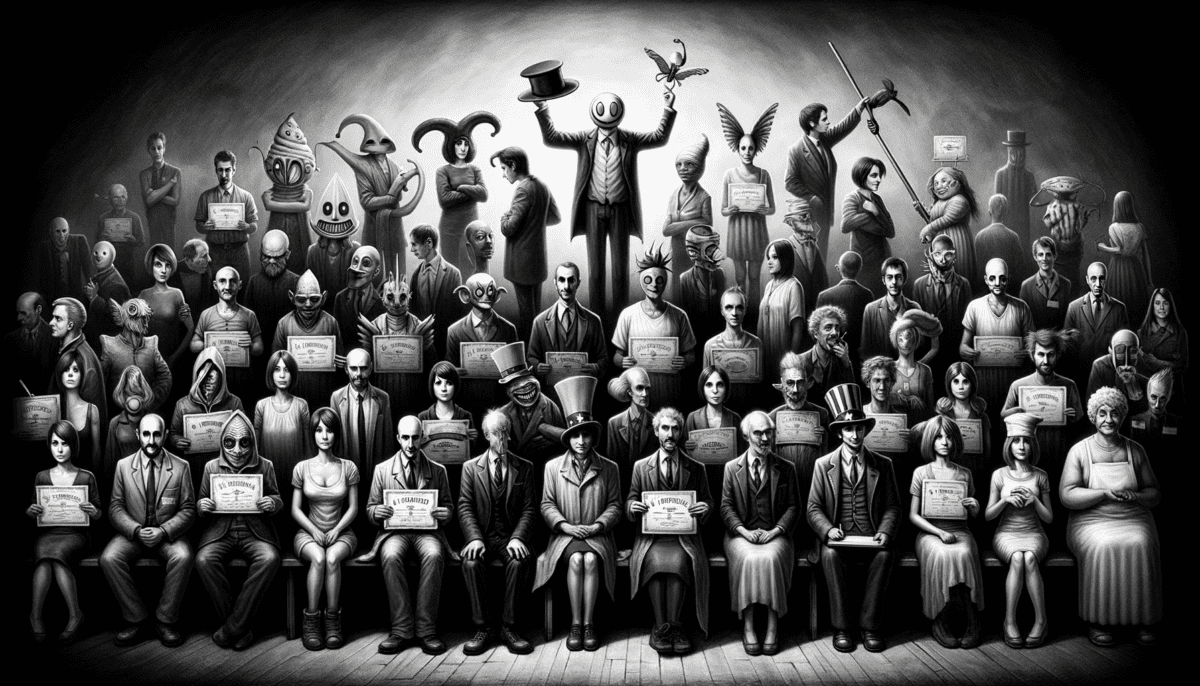


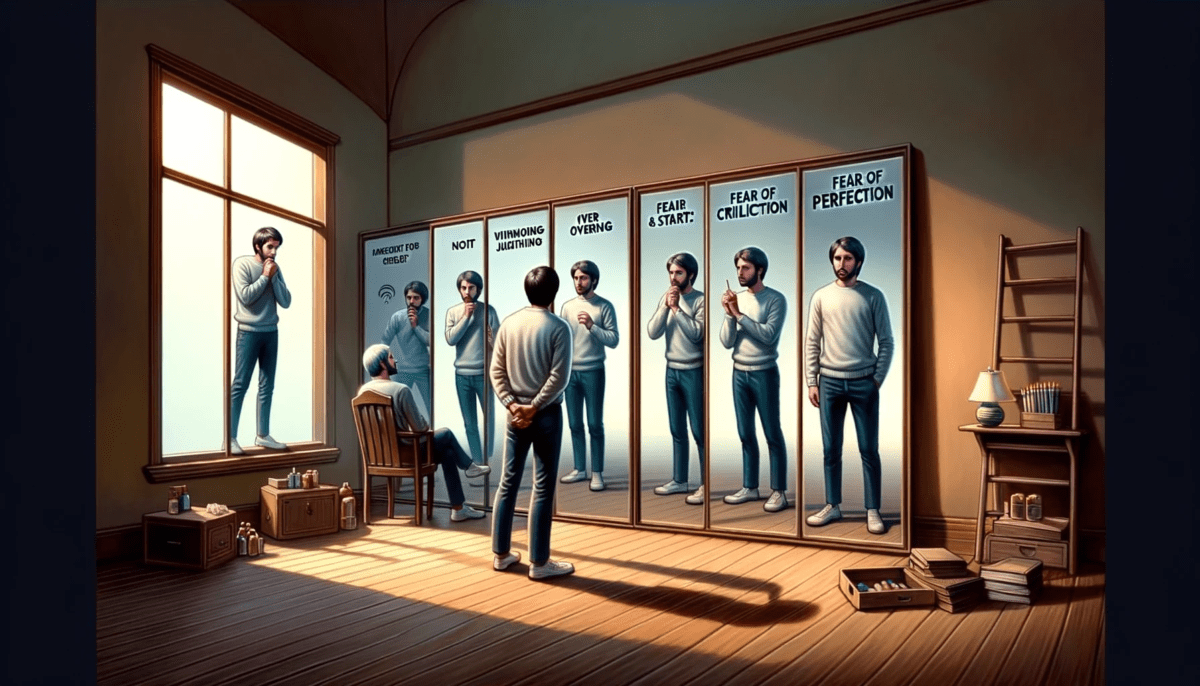













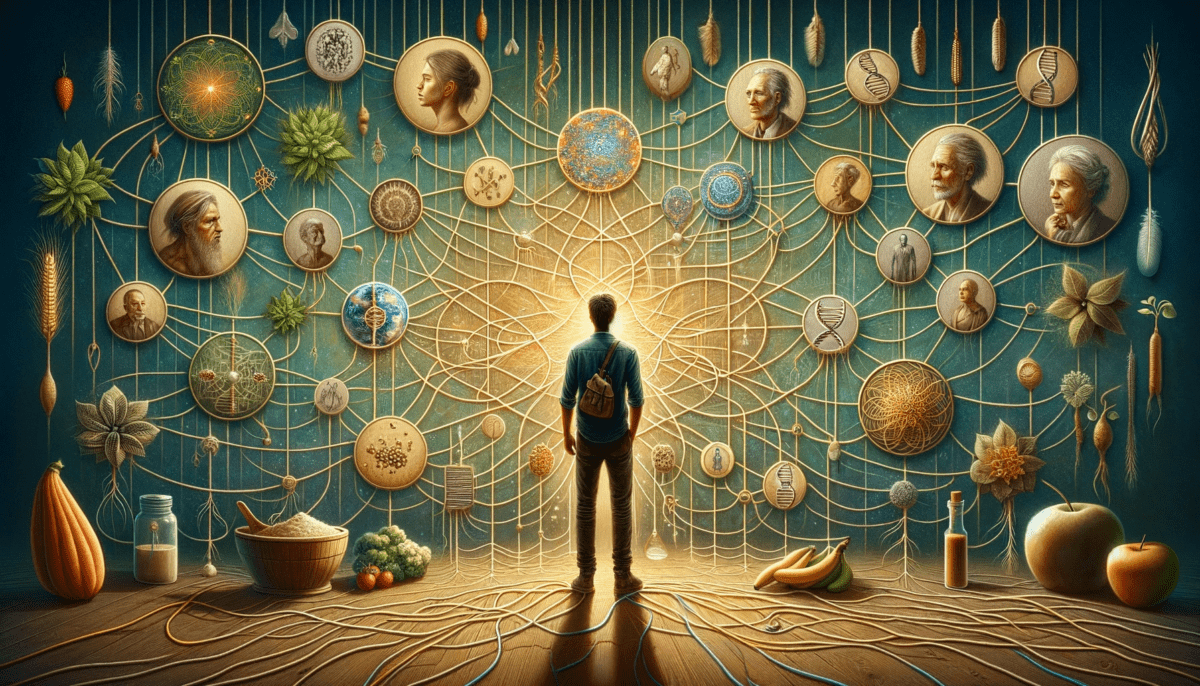





“Self Enquiry” is a profound and introspective internal dialogue presented in the form of a series of questions and responses. It delves into the nature of tension, opposition, and self-acceptance, exploring the complex relationship between personal identity, uncertainty, and the choices we make.
The dialogue begins by acknowledging the presence of tension and opposition within oneself. It explores the desire to let go of these qualities and the fear that may be associated with releasing them. The conversation contemplates the possibility that tension holds things together and that without it, there might be a loss of boundaries and a sense of uncertainty.
The dialogue reveals the acceptance of tension as an integral part of one’s experience, even if it is not fully liked or understood. It delves into the notion of self and the insecurities that arise from the uncertainty of what lies beyond one’s consciousness. It highlights the tendency to cling to the known and the familiar, even if it causes discomfort, as a way to maintain a sense of identity.
The conversation examines the self-imposed rules that contribute to the tension and opposition experienced. It questions the motivations behind staying within those rules and the fear of exploring the unknown. It touches upon the idea of personal empowerment and the recognition that we create our own reality, often by adhering to self-imposed limitations.
The dialogue concludes with a playful tone, highlighting the paradoxical nature of the human experience and the impermanence of our beliefs and perceptions. It suggests that the tension and opposition we encounter are part of a larger game, even if we don’t always like or fully understand it. The conversation hints at the timeless nature of existence and the vast possibilities that lie beyond our current understanding.
Overall, “Self Enquiry” prompts readers to reflect on their relationship with tension, opposition, and self-acceptance. It encourages embracing the uncertainty and exploring the boundaries of personal identity in order to gain a deeper understanding of oneself and the nature of existence.
We are Space Monkey.